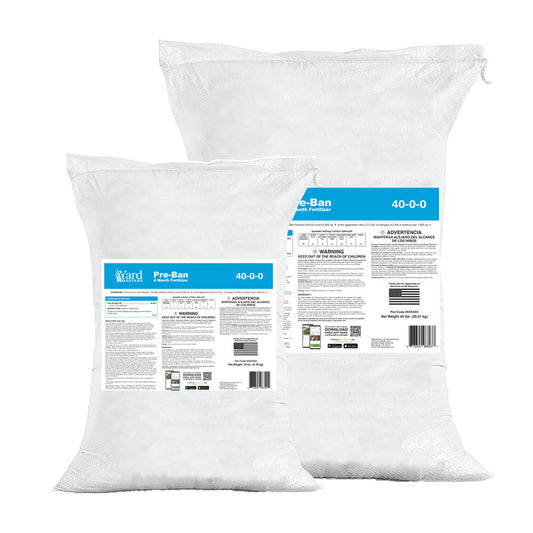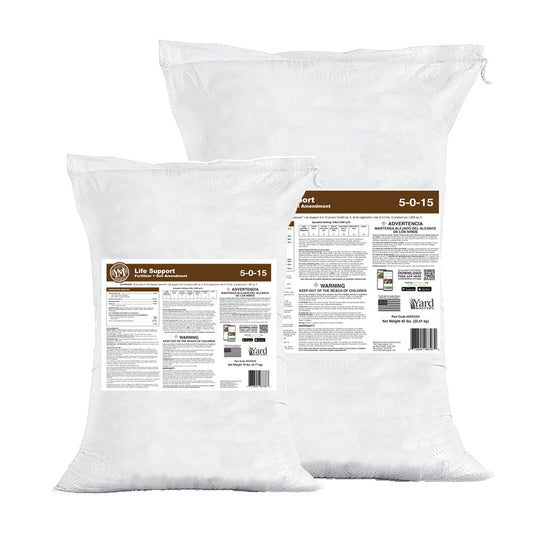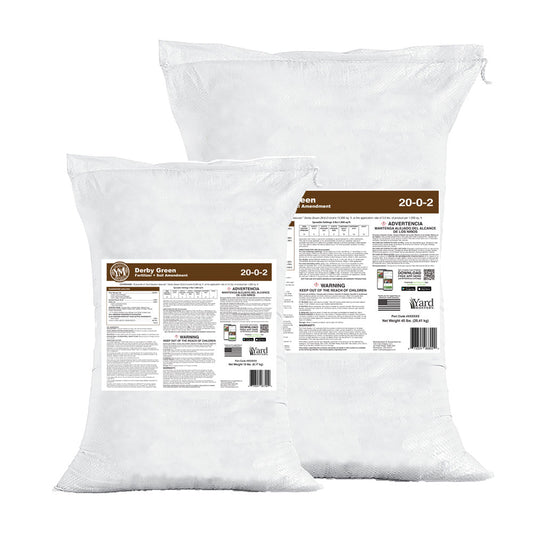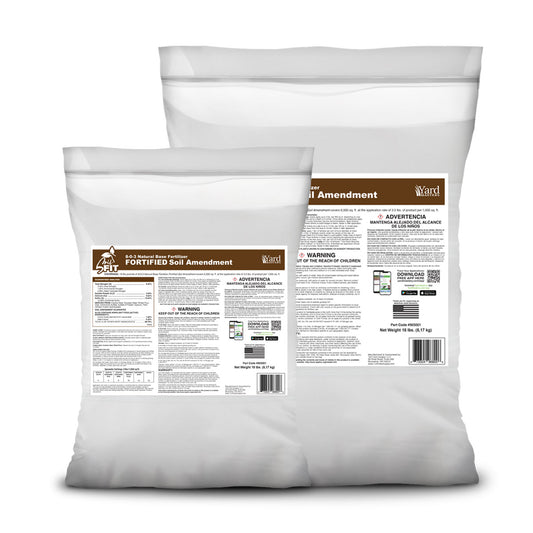If you remember in last week’s blog about The Ins and Outs of Lawn Fertilizers, I went into some of the basics of fertilizers, what they contain, and why. I also touched on some of the thinking processes that I like to use when choosing a fertilizer for the lawn. Be sure to review that post too!
Today I am now going to put that into practice and read a soil test for you and recommend some fertilizers that you would use if this was your test.
The idea is that I’m going to show you a real-world example - and I want you to look at the approach and then apply that to your own soil test.
Reading and Interpreting Your Soil Test
The test results you're about to see come from Lawn Care Nut, Brian Taylor out of Long Island, NY. (note: we have a lot of LCNs on Long Island, more than I can count - so I just have to believe that it truly is a VERY Long Island. 🙂
Here is Brian’s test (below) and it’s from his back yard. (his front yard test is nearly the same)
Note: you don’t have to test your front and back separately - the samples can be mixed - your soil from front to back to sides should not vary too widely.

So this test is showing you exactly what is available to your grass plants from your soil.
Our test is different than traditional university tests in that those require you to do some math in order to understand “available nutrients” vs “all nutrients in the soil.”
I don’t want to get too complicated here, but just so you know, oftentimes there are nutrients in your soil but they are not in a form that your plants can take in.
In other words, they are “locked up” due to pH or other reasons such as high salt content. When you get a test from a university, you have to do some math to understand what is actually available to plants vs what is sitting there unusable.
Most DIYers, (me included) ain’t got no time for all those chemistry calculations so, in my test, I have chosen a different technology that gives you “real-time nutrient availability” with no additional math needed.
Just look at the graph and choose fertilizers to help correct.
Note: remember like I said in my last blog post - you do not have to correct your soil in one miracle application.
The data you see above is directional - meaning - use fertilizers that move you into a better direction, over time. Like a blood test. Find out what is there now and what is lacking, adjust your lawn’s diet, and test again the following season to see how things have progressed.
Now let’s talk about some fertilizers.
General Purpose Fertilizers vs Specialty Fertilizers
I want you to think about fertilizers in two “categories”, general purpose and specialty.
General purpose fertilizers should ALWAYS be used in your program and should be the primary fertilizer you use, no matter what your soil test shows.
This is because first off, general purpose fertilizers are what almost all manufacturers make for us. I buy fertilizer off the shelf at Ace and Lowes too - just like you do. In this video, I am using a Weed/Feed I got at Lowes and the analysis is a 20-0-6.
These ferts will almost always contain Macronutrients Nitrogen and Potassium. They also have micronutrient Iron in most cases.
These ferts are put together like this because those elements are generally needed for green, healthy growth. In fact, this is primarily what most professional lawn companies use in their mixes as well. They never soil test, they just use general purpose fertilizers like these.
Brian in Long Island will probably treat his lawn with fertilizer 6 or 7 times this season - about every 5 weeks. (if you want a specific Lawn Care Program, click here, free updates coming soon)
So my recommendation to Brian is to use a “general purpose” fertilizer (Gen-Purp-Fert) on 3 or 4 of those applications.
He has cool-season turf (KBG/fescue/rye) and I like to push those hard right from the start of the season so he should use the “Gen-Purp-Fert” for the first application of the year for sure. Gen-Purps will have high nitrogen and remember, Nitrogen drives the bus - it’s the mega pusher we need for max green. Here are some pics of gen-purp-ferts:



Can you see how the general purpose fertilizer is also lining up with his soil test?
Even if his test showed high in Nitrogen or Potassium, you would still use general purpose fertilizers as a staple of your program because your lawn will use them up in large amounts and will need more. Same with micronutrient iron that is also contained in most of these ferts pictured above.
Funky Fresh Gen-Purp-Fert
Now you are Lawn Care Nuts and you don’t just want to use the full synthetic stuff from shelves all the time right?
You like adding in some other goodness to not only feed the turf, but to boost the soil. You like humic acid and sea kelp as these bio-stimulants help the soil to retain more of the nutrients you apply as well as use them more efficiently and these simulants also push more roots and chutes. Kind of like drinking a pre-workout drink before you hit the gym.
Here are some general purpose fertilizers that are hopped up with extra goodies to feed the soil microbes and stimulate roots and chutes along with the feed:

FLAGSHIP 24-0-6 contains micronutrients and bio-solids to feed microbes in the soil.
18-0-1 Greene Punch liquid. Juiced with humic acid and sea kelp.
You won’t find this type of fertilizer at big box stores because the majority of their customers are not educated enough to care about those things so the box stores keep it simple.
Totally understandable and there is a place for big box store fert in every program. In fact, many of you like to stick with the tried and true “Scott’s 4-Step” and I think that is all good. I’d just recommend you supplement that with some liquid Bio-Stimulants.
I made a video last weekend talking about Spring Pre-Emergents & Biostimulants and how to use them (time stamped).
Specialty Fertilizers
So now that you are set to apply your general purpose fert a few times over the course of the season, let’s next explore specialty ferts. These are fertilizers that are used just for certain, specific tasks.
The most popular term you will find among specialty fertilizers is “starter fertilizer” which is used to help start grass seed or help new sod root quickly. In this case, the element most needed for seed and sod root production is phosphorus (P) so you will find that element high in these ferts.
That term “starter fertilizer” is really just a marketing term to help buyers understand the fert’s purpose. What we really care about though, is the analysis. Remember, we want to know the N-P-K and micros associated with that fertilizer so we can use that fert to help correct our soil in our existing lawn.
You see, starter fertilizer isn’t just for seed and sod, it’s for anytime you need what’s in it. Let’s look at the two starter ferts that we carry as examples.
Add some Greene POP if your build-a-box if you need it!
Now you wouldn’t want to use this fertilizer all the time because you don’t want a buildup of phosphorus in your soil but if you need phos, this is one you’d use 2-3 times per year to correct your deficiencies.
Keep in mind, many municipalities have phosphorus bans and you can only use these ferts if your soil test indicates you need it!
Of course, just like all the stuff John Perry makes, it’s kicked up with Humic Acid and Sea Kelp to further stimulate soil activity and rooting.
Starter Fert Fixes Everything
If you prefer granular products, our 12-12-12 Starter Fertilizer has premium sources of N and K as well as 12% phos to help if you have a deficiency there as well.

For Brian’s test, you can see we recommended these two ferts. That is because they help correct his deficiency in phos. I would recommend he use one of these on 2 or maybe 3 applications this year, but no more than that.
MicroNutrients
So far we have mostly talked about macros but those micros (also called “minors”) are just as important.
And I want to stress that: they are equally as important as the macronutrients, however they are just needed in smaller quantities for the plant to perform optimally.
Think of this like fluids in your car. My Tundra has a 35 gallon gas tank and let me tell you, it drinks that gas! Gas is like Nitrogen in this case.
However, because of all that burning up of fuel, it also needs oil to keep everything properly lubricated. But it only needs 8.5 quarts of oil to accomplish this task. Oil is like a micronutrient for the engine.
If you are lacking in either one of these, gas or oil, your Tundra won’t be going very far down the road.
Get it?
Now as I have illustrated above, most of the general purpose ferts, and even the specialty ferts, don’t contain too many micros as listed on the label.
So we have a liquid product that also comes inside the Bio-Stimulant pack that is a full stack of the primary micronutrients needed for lawns. That is the 0-0-2 MicroGreene and you will see that recommended in Brian’s test above as well.
I actually recommend that all of you, soil test or not, incorporate MicroGreene into your program. Just apply it a few times per year at the label rates and it will keep all the minors in line for you, simple and complete, all good.
If you look at Brian’s test above, you will see he is ok on copper but yet the MicroGreen has copper - is this bad? No it’s not, it’s fine, just roll with it.
There is really no possible way for us to formulate a micronutrient product that can fit 100% of soil tests perfectly so we have this product that hits most of the marks. Anything extra will just be there and won’t harm anything.
We don’t have very much of this in stock right now. I didn’t even do any content on it outside of a few pictures and most of it sold. I have more on order and should have more by early next week - I hope.
What About Lime?
I don’t want to leave out that pH and the lime recommendation. We will have some generic recs on there like this one from time to time. You will see it is recommending dolomitic lime. That is because this lime has both calcium and magnesium which he needs in his results.
Lime can also be used to raise pH.
However, be mindful, it takes ALOT. I say “ALOT” because it literally could take 100 lbs/1,000 sq ft of lime to raise your pH even one point. There is no possible way to get that to happen in one season, and in fact, it may take years.
So in that case, I asked him to send me a picture of his lawn because if your pH is off, I always ask “well does your lawn look good?”

As you can see, lawn looks great last October! (He’s been on my Digital Lawn Care Programs) So that tells me his lawn runs just fine being a little off on the pH. Just like some people have faster resting heart rates than others - but both can be very healthy.
So while I think he should apply lime, just get some in here in the spring and again next spring and so on. Just spoon it in over time, directionally. You will most likely find lime at garden centers and whatever you get, apply as much as you feel comfortable with… it’s hard for me to know the prill size of what you will get, and some even comes in powder form. (sometimes called “quicklime”)
This product fro Jonathan Green can work well in helping you raise your pH and it's formulated to flow easily through DIYer spreaders. You can use this a couple times in spring 4-5 weeks apart and again in the fall to help move your pH without all the mess!
Ending Summary
I’m going to end this one now and in my final email of this series I will break down some other soil tests and give specific recommendations on what to buy either from the store, or from our shop or a combination of both.
I’ll also be working on a video to describe this in even more detail. In the meantime, have a great week and I’ll see you in the lawn!
AL










